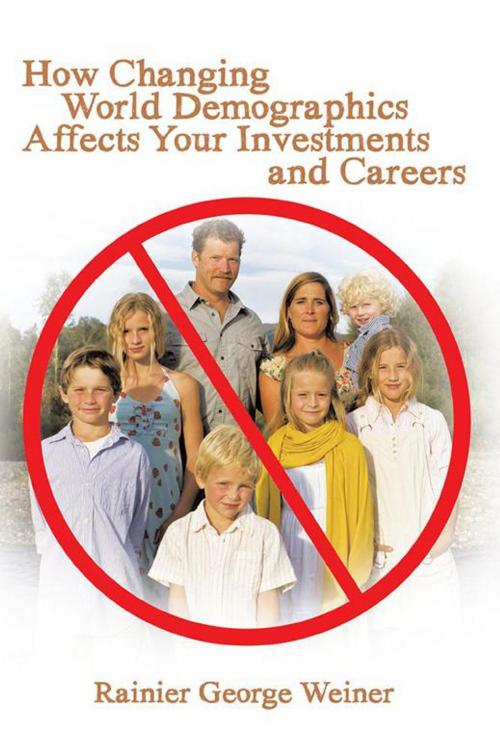| Author: | Rainier George Weiner | ISBN: | 9781496914743 |
| Publisher: | AuthorHouse | Publication: | July 28, 2014 |
| Imprint: | AuthorHouse | Language: | English |
| Author: | Rainier George Weiner |
| ISBN: | 9781496914743 |
| Publisher: | AuthorHouse |
| Publication: | July 28, 2014 |
| Imprint: | AuthorHouse |
| Language: | English |
Using the principles in this book, the individual investor, the small business man, corporate executives and those developing careers, have a unique opportunity to prepare a strategy for the sea changes in investment choices, consumer demand, business opportunities and social changes forthcoming. Not doing so will ensure failure. At the turn of the 20th Century approximately one out of every three people on earth were of Caucasian or white ancestry. By the year 2000 that number stood at one out of seven. By the end of this century, demography experts predict that number to plunge to one out of twenty. Likewise in the United States, in 1900, approximately nine-tenths of the population was white. By 2000 that number had dropped to seven-tenths. Demographers project that number to be less than one half by 2053 and a little more than a third by the end of the century. The reason? If you were to ask the layman on the street he might respond Its because Africans, Asians, Indians or Middle Easterners are reproducing in large numbers. However, in actuality, the birth rates of these developing populationsthough still at a high levelhave themselves declined over 50 percent in recent years. The core reason for this disproportionate Caucasian decline is their own extraordinarily low birth ratesthe subject of this book. From the days of early Rome, throughout the reign of the Titans, into the development of constitutional law and the cultural and technological breakthroughs of the 20th Century, indisputably, Caucasians have led the charge and reaped the concomitant high living standards, asset, status, and wealth benefits. This will begin to change by mid century. Many celebrated authors in the demographics field have written books on this birth decline phenomenon. Some of the more prominent include: Fewer: How the New Demography Will Shape Our Future, by Ben Wattenberg; The Empty Cradle: How Falling Birth Rates Threaten World Prosperity and What to Do About It, by Paul Longman; A Question of Numbers: High Migration, Low Fertility, and the Politics of National Identity by Jay Winters and Michael Teitlebaum; Global Aging and its Economic Consequences by Robert Lee. All of these books delineate clearly the problems associated with birth decline. All note the dramatic consequences particularly amongst Western societies. This book, however, stands alone in giving the philosophical/ideological underlying causes (The 7 basic principles) for these dramatic changes in birth rates since the mid 60s in the United States and the rest of the world. In addition, these publications miss the opportunity to prepare the reader to capitalize on the investment, business and employment effects of this phenomenon. It prepares the reader to adjust his thinking to an age of population decline before the effects leave him behind the curve of change.
Using the principles in this book, the individual investor, the small business man, corporate executives and those developing careers, have a unique opportunity to prepare a strategy for the sea changes in investment choices, consumer demand, business opportunities and social changes forthcoming. Not doing so will ensure failure. At the turn of the 20th Century approximately one out of every three people on earth were of Caucasian or white ancestry. By the year 2000 that number stood at one out of seven. By the end of this century, demography experts predict that number to plunge to one out of twenty. Likewise in the United States, in 1900, approximately nine-tenths of the population was white. By 2000 that number had dropped to seven-tenths. Demographers project that number to be less than one half by 2053 and a little more than a third by the end of the century. The reason? If you were to ask the layman on the street he might respond Its because Africans, Asians, Indians or Middle Easterners are reproducing in large numbers. However, in actuality, the birth rates of these developing populationsthough still at a high levelhave themselves declined over 50 percent in recent years. The core reason for this disproportionate Caucasian decline is their own extraordinarily low birth ratesthe subject of this book. From the days of early Rome, throughout the reign of the Titans, into the development of constitutional law and the cultural and technological breakthroughs of the 20th Century, indisputably, Caucasians have led the charge and reaped the concomitant high living standards, asset, status, and wealth benefits. This will begin to change by mid century. Many celebrated authors in the demographics field have written books on this birth decline phenomenon. Some of the more prominent include: Fewer: How the New Demography Will Shape Our Future, by Ben Wattenberg; The Empty Cradle: How Falling Birth Rates Threaten World Prosperity and What to Do About It, by Paul Longman; A Question of Numbers: High Migration, Low Fertility, and the Politics of National Identity by Jay Winters and Michael Teitlebaum; Global Aging and its Economic Consequences by Robert Lee. All of these books delineate clearly the problems associated with birth decline. All note the dramatic consequences particularly amongst Western societies. This book, however, stands alone in giving the philosophical/ideological underlying causes (The 7 basic principles) for these dramatic changes in birth rates since the mid 60s in the United States and the rest of the world. In addition, these publications miss the opportunity to prepare the reader to capitalize on the investment, business and employment effects of this phenomenon. It prepares the reader to adjust his thinking to an age of population decline before the effects leave him behind the curve of change.















